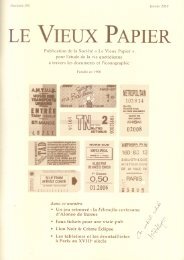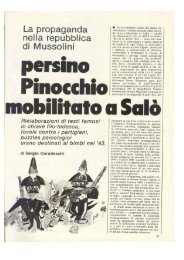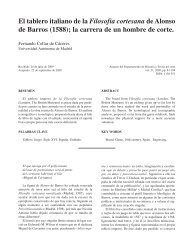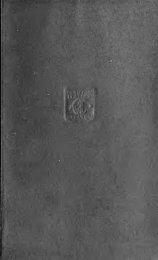Board games from the city of Vijayanagara (Hampi ... - Gioco dell'Oca.
Board games from the city of Vijayanagara (Hampi ... - Gioco dell'Oca.
Board games from the city of Vijayanagara (Hampi ... - Gioco dell'Oca.
Create successful ePaper yourself
Turn your PDF publications into a flip-book with our unique Google optimized e-Paper software.
10<br />
B OARD G AME S TUDIES 6, 2003<br />
When Russians in Siberia played sáhkku <strong>the</strong>re in <strong>the</strong> 1890s, <strong>the</strong>y apparently followed<br />
a quite different tradition. According to <strong>the</strong> Swedish scientist V. Carlheim-Gyllensköld,<br />
<strong>the</strong>y used to play with 2x13 warriors and one king on a 3x13 lines board. In this game<br />
3 small 6-sided dice were used. One side was marked with a cross, named sakko, <strong>the</strong><br />
o<strong>the</strong>r sides with 1, 2, 3 and 4 strokes, while <strong>the</strong> sixth side was left blank. (3) This deviating<br />
dice tradition is very interesting, but for <strong>the</strong> present it is very difficult to say if this<br />
tradition is older or younger than <strong>the</strong> Scandinavian one.<br />
Did <strong>the</strong> four-sided Scandinavian dice reach Scandinavia toge<strong>the</strong>r with <strong>the</strong> <strong>games</strong>? If<br />
this is <strong>the</strong> case, <strong>the</strong>y probably had <strong>the</strong>ir origin somewhere in <strong>the</strong> Islamic world. The random<br />
generators connected with <strong>the</strong> tâb or sîg <strong>games</strong> <strong>of</strong> Africa and Asia are very different<br />
<strong>from</strong> those used in daldøs(a) and sáhkku, however. In a few cases sea shells are used,<br />
<strong>the</strong> so-called “cowries”, but more <strong>of</strong>ten <strong>the</strong>se <strong>games</strong> are played with two-sided dice sticks.<br />
Alternatively, <strong>the</strong> dice used in <strong>the</strong> two Scandinavian <strong>games</strong> may have had <strong>the</strong>ir roots in<br />
Nor<strong>the</strong>rn Europe.<br />
In my search for possibly related types <strong>of</strong> dice I have discovered several Nor<strong>the</strong>rn<br />
European types <strong>of</strong> four-sided dice sticks, which apparently have been overlooked by<br />
scholars. At least I have not been able to find any systematic investigation <strong>of</strong> <strong>the</strong>se. I<br />
think <strong>the</strong>y are quite interesting in <strong>the</strong>mselves, regardless <strong>of</strong> <strong>the</strong>ir eventual relationship<br />
with <strong>the</strong> daldøsa and sáhkku dice.<br />
The North-European stick dice which I will discuss in this article, can be divided into<br />
three groups:<br />
1) stick dice used in a vertical race game,<br />
2) stick dice used in ‘put-and-take’ or ‘teetotum’ <strong>games</strong>,<br />
3) stick dice used in out door stick <strong>games</strong> as a substitute for a stick or ball.<br />
Climbing to heaven – a Nor<strong>the</strong>rn Swedish shepherd’s game<br />
In 1908 <strong>the</strong> Swedish ethnologist Nils Keyland described <strong>of</strong> a peasant game which<br />
may be regarded as a sort <strong>of</strong> vertical race game. (4) This Nor<strong>the</strong>rn Swedish shepherd’s<br />
game is testified <strong>from</strong> Värmland, Dalarna, Jämtland, as well as <strong>from</strong> <strong>the</strong> nor<strong>the</strong>rnmost<br />
Swedish regions: Norrbotten and Västerbotten where it was known as fårhimmel “sheep<br />
heaven” (Fig. 2 and 3). In Dalarna it was called att kappas till gudsrike or klättra till<br />
himla “competing for <strong>the</strong> kingdom <strong>of</strong> God” or “climbing to heaven”. The game was also<br />
known in Estonia and in Finland, where it was called himmelsstegen “<strong>the</strong> ladder to heaven”.<br />
(5) I have not been able to find any references to o<strong>the</strong>r <strong>games</strong> <strong>of</strong> this type.<br />
This race game is played by two (or more) persons with a roughly 1 m long Jakobståkki<br />
“Jacob’s ladder”, which is usually carved <strong>from</strong> a tiny tree top with bits <strong>of</strong> branches<br />
left on two <strong>of</strong> its sides. Each player has a small branch fork or hook, about 5 cm long.<br />
Both (or all) players use <strong>the</strong> same 3 cm long wooden die. One <strong>of</strong> its sides is marked with<br />
a cross, on <strong>the</strong> next side it has one stroke, and on <strong>the</strong> following side two strokes. The last<br />
side is blank. The ladder is set upright in <strong>the</strong> field. One player throws <strong>the</strong> die up into <strong>the</strong><br />
air. If it falls down with one stroke up, <strong>the</strong> thrower may hang up <strong>the</strong> hook on <strong>the</strong> first<br />
(lowest) twig. Should it fall down with two strokes up, <strong>the</strong>n he is allowed to move it<br />
two steps up in stead, placing it on <strong>the</strong> second twig. The person who throws is permit-







